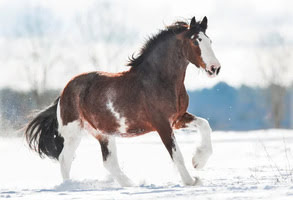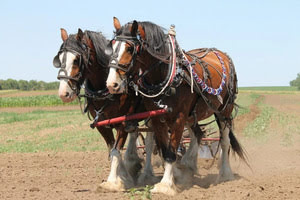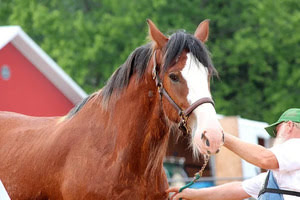1.The hooves of Clydesdales are the size of a dinner plate
Giant horses require proportionately massive feet to spread their weight over a larger surface. Clydesdales’ massive hooves offer the required foundation and support to their body, allowing them to avoid ailments such as navicular.
Clydesdales, unlike other draft breeds, were purposefully developed to have exceptionally wide feet. This characteristic was useful in the rainy Clyde Valley, where horses had to work on soft farmlands all year. Clydesdales’ strong shock-absorbing abilities makes them perfect for hauling carriages or parading through the city.
Shoeing these horses is also no easy process. A single horseshoe for an adult Clydesdale weighs around 5 pounds (2.27 kg), which is four times the weight of a racing shoe.

Furthermore, Clydesdales in conformation classes typically wear a “Scotch Bottom” shoe. This particular shoe widens their hooves and causes them to walk with a high stepping gait. These characteristics are desired in hitch and halter horses.
2.An average Clydesdale eats twice as much as a regular horse
Horses should ingest 1.5-2% of their body weight in feed every day as a general guideline. The majority of their diet should include high fiber foods like grass or hay, with a tiny quantity of concentrate feed on the side.
Clydesdales are inherently voracious eaters due to their larger-than-average size.An average adult will consume 25-40 pounds (11-18 kg) of hay per day, which is approximately half the weight of a small square hay bale. Most Clydesdales will also receive 2-10 pounds (0.9-4.5 kg) of concentrate feed per day, divided into two or three meals.

Performance Clydesdales, on the other hand, will eat even more. Budweiser horses are fed 50-60 pounds of hay per day (about 25 kg) and roughly as much concentrate.
If you’re thinking about getting a Clydesdale, you should consider their massive feed and room requirements. A fully grown adult will consume 30 gallons (114 liters) of water every day, so you must always have fresh water available.
3.Clydesdales are a rare horse breed
A long time ago, the world was home to tens of thousands of Clydesdale horses. However, their numbers sharply decreased as a result of the First World War and the industrialization of agriculture. There are currently just a few number of thousand Clydesdales left, predominantly in the US, Canada, Australia, and the UK.

The breed has been designated as “at risk” globally by the Domestic Animal Diversity Information System (DAD-IS) as of 2020. In the same year, the Clydesdale was classified as being in danger of going extinct in the UK by the Rare Breeds Survival Trust (RBST). Less than 900 Clydesdale broodmares are left in the nation where the breed originated.
Although Clydesdales have a stable population today, they have previously faced extinction on multiple occasions. There were just 80 Clydesdales registered worldwide in 1975, according to Karina Brez. Fortunately, that number has now increased to over 5,000, and every year, about 600 Clydesdales are registered in the US alone.

The breed’s impressive comeback was partly due to the Anheuser Bush company featuring Clydesdales in their Budweiser commercials. The charming TV adverts showed off the breed’s elegance, beauty and kind nature, popularizing these gentle giants once again.


